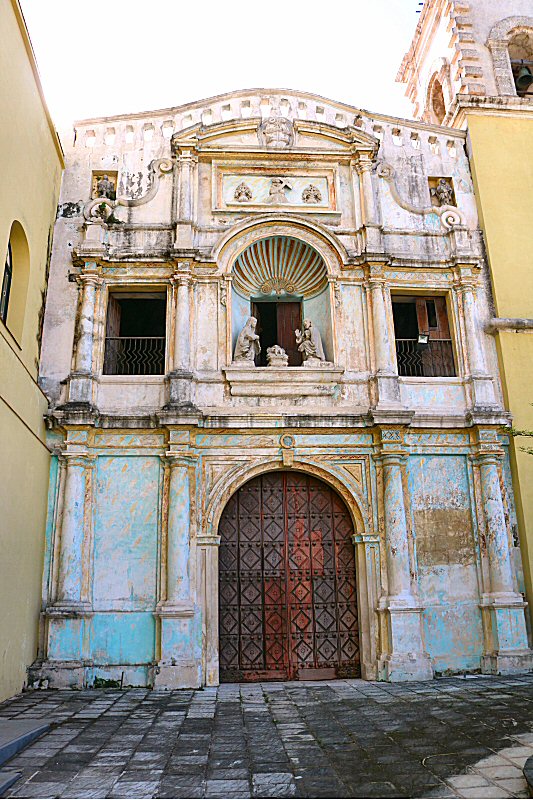
The Iglesia y Convento de Belén is located on the Compestela street #662, occupying the block bordered by the Luz, Picota and Acosta streets.

 The religious complex is composed of
a church and a convent. A peculiar vaulted arch, built over
the Acosta street, connects the convent to the neighbor
buildings.
The religious complex is composed of
a church and a convent. A peculiar vaulted arch, built over
the Acosta street, connects the convent to the neighbor
buildings.
When the first members of the Order
of Bethlehem arrived in Cuba, they asked the Bishop Diego
Evalino de Compostela (1638-1704) for his advice to build
their convent. With the contribution of Compostela that had
already an idea to create an appropriate place for the
recovery of sick people, discharged from the hospitals of
the city, the first stone of the church and the hospital was
laid. After the death of the bishop the friars used the
incomplete building as a center to care for sick people and
to distribute food to the poor. The construction of the
hospital and the church restarted in 1712 and the church and
first cloister that served as a school and infirmary, were
completed in 1718.
In the 18th century, even though there
were already good schools like Colegio Seminario de San
Carlos, founded by the Bishop Diego Evalino de Compostela as
a higher education institute of the Catholic Church in 1689,
wealthy families were sending their children to Spain, in
order to complete their studies prior to entering the
university there. Even so, the children of a significant
sector of the aristocracy, merchants and other well-known
Creoles and Spaniards, residing in Havana, were receiving
their education from the Jesuits, as they were highly
credited by their discipline in following the precepts of
the Catholic religion. The College of San José, in that the
Jesuits held office, was the preferred institution until
1767, when the Jesuits were expelled from Spain and the
overseas territories.
When the ostracism of the Jesuits
was terminated by Pope Pius VII in 1814, they could return
to the island. In 1852, Queen Elizabeth II authorized by a
royal decree the establishment of a new secondary school in
Havana under the aegis of the Jesuits. The Captain General
Marquis de la Pezuela assigned the building of the
betlemites for the new school in 1854 that had already been
confiscated by the Spanish colonial government years ago, in
1842. The betlemites had been evicted and since that time
the building had been occupied by the second gabo
(vice-captain general) and a battalion of the infantry.
When the soldiers left the building,
it was almost in ruins with split walls and occluded doors
and windows. The building became the property of the Jesuits
that had been able reestablish their society long ago, in
order to compensate their properties that had been
confiscated by the government a century ago. In 1854 the
Jesuits succeeded in making two classrooms in the Bethlehem
building ready for the education, and after a formal opening
in the same year, the Real Colegio de Belén started with the
education.
In 1896, a third level was added to the building on the south wing, destined for the observatory library and a room for weather forecasts and climatologic works. Between 1904 and 1910, on the occasion of the 50th anniversary of the college, the third level was completed in the north wing, and the astronomical tower was erected, in which the Observatory Museum is inaugurated today. The area of the religious complex reached to ten fold of its original area, when the expansion process was completed in 1909.
Beytüllahim or Betlehem is a city
in the center of the West Bank in Palestine, known as the
birthplace of Jesus.
The Order of Our Lady of Bethlehem
was established by Pope Pius II in 1459. The purpose of this
order was to defend the island Lemnos in the Aegean Sea that
was taken from Mehmed II (Fatih Sultan Mehmet), but when
the island was recaptured by the Turks the Order of Our Lady
of Bethlehem was suppressed, almost as soon as it was
established.
The Order of Bethlehemite Brothers
or Bethlehem Brothers (Hermanos de Belén) are a religious
institute founded by Pedro de Betancourt in Guatemala in
1653. They are also known as the Order of the Brothers of
Our Lady of Bethlehem (Orden de los Hermanos de Nuestra
Señora de Bethlehem).
The Jesuits were successful not only
in the administration of the college, but also in the
meteorological observations. They had established several
observatories in different countries until that time, such
as in Vatican, Britain, and Belgium. The Colegio Romano,
better known as the Vatican Observatory, was their first
observatory (1824), the Havana’s Real Observatorio (Royal
Observatory) being the fifth. In the Real Observatorio, the
climatologic observations were made on the top of the
school uninterrupted for 103 years, from 1858 to 1961. The
Jesuits, the first official weather forecasters of Cuba,
used the observatory particularly to study of hurricanes.
Their effort raised the observatory that was the first of
its kind in the Caribbean, to one of America 's most important
weather stations
The accuracy of the meteorological
data based not only on the persevering work of the observers
(students and teachers) in Bethlehem Observatory, but also
on the high-level technology that they were using. They had
imported a new continuous record meteorograph, called Secchi,
from France in 1873, that recorded continuously the values
of the atmospheric pressure, the direction and speed of
the wind, the temperature and humidity of the air and the
amount of the rain fall. At that time, the devices of that
type were not more than ten in the whole world.
Another value of these meticulous meteorological observations was their use in the work of the Cuban doctors Ambrosio González del Valle and Carlos Juan Finlay on the transmission of cholera and yellow fever.